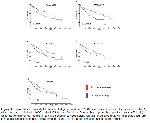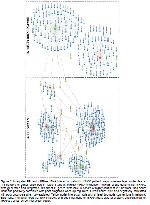HCC is the second deadliest cancer type with approximately 850.000 annual new cases and poor survival rates
1. Known prognostic biomarkers of HCC are insufficient to monitor disease progression or develop novel molecularly targeted therapeutic applications
1. Thus, identification and characterization of novel patient survival affecting molecules are needed for HCC. Up to now, variable prognostic biomarkers such as differentially expressed protein coding or non-coding RNAs (especially miRNAs), mutation profiles, and epigenetic modifications such as DNA methylation patterns have been determined for HCC
3. Among these identified biomarkers, AFP and Glypican 3 (GPC3) expression display the highest patient OS time predictive efficiencies for HCC. However, these biomarkers display limitations in sensitivity and specificity for prognosis monitoring and novel biomarkers should be urgently identified for HCC
3. Thus, DNA-Seq, mRNA-Seq and miRNA-Seq data of HCC patient samples of TCGA were analysed and integrated to identify novel patient OS affecting biomarkers for HCC.
In this study, 11 genes and two miRNAs, whose predictive expression patterns showed correlation with patient OS time by using bioinformatics data of TCGA HCC patient samples were determined. Among them, differential expressions of A1BG, CCT3, COL18A1, NCL, PIK3R1, PRKDC, PYGO2, miR-1180, and miR-139-5p were previously reprted as poor prognosis biomarkers for cholangiosarcoma 11, multiple myeloma 12, non-small cell lung cancer (NSCLC) 13, acute myeloid leukemia 14, breast cancer 15, gall bladder cancer 16, lung cancer 17, pancreatic adenocarcinoma 18, and NSCLC 19, respectively.
Among identified genes and miRNAs, increased levels of CCT3 20, PYGO2 21, SRRT 22, NCL 23, PRKDC 24, TNPO1 25, miR-1180 26, and miR-139-5p 27 were previously reported to be correlated with poor prognosis of HCC patients (Table 1). Indeed, identification of these genes and miRNAs strengthens the credibility of identified novel candidates as prognostic biomarkers (Table 1). Among 11 genes in Table 1, five of them (GPATCH4, PPARGC1A, PIK3R1, COL18A1, and A1BG) were correlated with HCC patients OS estimation for the first time with this study (Table 1, Figure 1).
Upon literature search focusing on HCC, GPATCH4, which ranked five in the list (Table 1), comes out as a strong prognostic marker candidate as it locates in chromosome 1q21-24 region along with CCT3 and PYGO2 whose upregulations were previously correlated with poor prognosis of HCC 20,21. Moreover, PIK3R1, whose expression negatively correlated with HCC patient OS time within this study, has the potential to be a strong candidate, since it was previously shown to be regulated by miRNAs involved in growth suppression of HCC 28. PPARGC1A, which was shown to mediate HCC cells migration through modulating E-cadherin expression 29, is a promising prognostic biomarker and therapeutic target candidate particularly for prevention of HCC metastasis. COL18A1 also comes out as an interesting target since its overexpression was shown to be associated with HCC previously 30. Lastly, there is no reported study in the literature about A1BG genes functional role in HCC, which makes it an interesting candidate for further analysis.
The miRNA-Seq analyses identified that the differential expression of only two miRNAs miR-1180- 3p and miR-139-5p are associated with poor prognosis of HCC. Altough these miRNAs have recently been experimentally associated with poor prognosis of HCC (26, 27), an integrated network of HCC prognosis-associated mRNAs and miRNAs has been generated for the first time. Interestingly, the mRNA sub-network revealed six novel candidate HCC prognosis-related proteins (Figure 2a). The other sub-network consists of two miRNAs, both targeting DUSP22 mRNA (Figure 2b). Both sub-networks are connected via miR-139-5p through CCT5, TNPO1, HSP90AA1, and JUN mRNAs that are direct targets of miR-139-5p (Figure 2). Thus, miR-139-5p, which is down-regulated in HCC patients with poor prognosis, may be an important hub regulator of HCC patients survival because miR-139-5p has direct connection with TNPO1 and indirect connections with CCT3, NCL, and PRKDC genes that are also associated with poor prognosis of HCC (Table 1, Figure 2).
In conclusion, this study identified a network of novel biomarker candidates for prediction OS time of HCC patients. Identification of the roles of these molecules with future studies may provide novel information to better monitor disease prognosis and develop novel targeted therapeutic applications against HCC.





